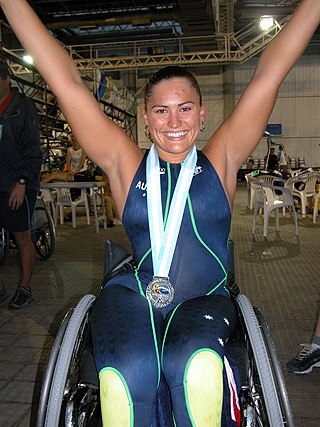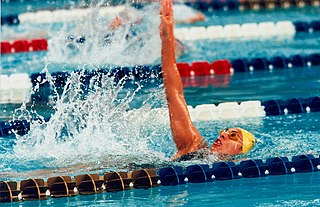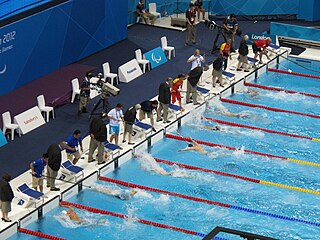S13, SB13, SM13 are para-swimming classifications used for categorising swimmers based on their level of disability. Jane Buckley, writing for the Sporting Wheelies, describes the swimmers in this classification as having: "Swimmers who are the most sighted but are considered to be blind according to the IBSA B3." [1]
The classification was created by the International Paralympic Committee. In 2003 the committee approved a plan which recommended the development of a universal classification code. The code was approved in 2007, and defines the "objective of classification as developing and implementing accurate, reliable and consistent sport focused classification systems", which are known as "evidence based, sport specific classification". In November 2015, they approved the revised classification code, which "aims to further develop evidence based, sport specific classification in all sports". [2]
For the 2016 Summer Paralympics in Rio, the International Paralympic Committee had a zero classification at the Games policy. This policy was put into place in 2014, with the goal of avoiding last minute changes in classes that would negatively impact athlete training preparations. All competitors needed to be internationally classified with their classification status confirmed prior to the Games, with exceptions to this policy being dealt with on a case-by-case basis. [3]
This classification is for swimming. [1] In the classification title, S represents Freestyle, Backstroke and Butterfly strokes. SB means breaststroke. SM means individual medley. [1] Jane Buckley, writing for the Sporting Wheelies, describes the swimmers in this classification as having: "Swimmers who are the most sighted but are considered to be blind according to the IBSA B3." [1]
Internationally, the classification is done by the International Blind Sports Association. [4] In Australia, to be classified in this category, athletes contact the Australian Paralympic Committee or their state swimming governing body. [5] In the United States, classification is handled by the United States Paralympic Committee on a national level. The classification test has three components: "a bench test, a water test, observation during competition." [6] American swimmers are assessed by four people: a medical classifier, two general classifiers and a technical classifier. [6]
For this classification, organisers of the Paralympic Games have the option of including the following events on the Paralympic programme: 50 m, 100 m and 400 m Freestyle, 100 m Backstroke, 100 m Breaststroke, 100 m Butterfly, 200 m Individual Medley, and 4 × 100 m Freestyle Relay and 4 × 100 m Medley Relay. [7]
In the S13 50 m Freestyle Long Course, the men's world record is held by Oleksii Fedyna and the women's world record is held by Yvonne Hopf. [8] In the S13 100 m Freestyle Long Course, the men's world record is held by South Africa's Charles Bouwer and the women's world record is held by Canada's Valerie Grand-Maison. [9] In the SB13 100 m breaststroke, the women's world record is held by Fotimakhon Amilova.
Swimmers who have competed in this classification include Dmytro Aleksyeyev, [10] Kelley Becherer [10] and Charl Bouwer [10] who all won medals in their class at the 2008 Paralympics. [10]
American swimmers who have been classified by the United States Paralympic Committee as being in this class include Gia Pergolini, Eric Chausse, Natalio Abar, and Blake Adams. [11]

Marayke Caroline Jonkers is a retired Australian Paralympic swimmer and paratriathlete. She won two bronze medals at the 2004 Athens Paralympics and a silver medal at the 2008 Beijing Paralympics, along with a bronze medal at the 2010 Budapest ITU Triathlon World Championships.

Prue Watt, is a Paralympic swimming gold medalist from Australia. She has represented Australia at the four Paralympics from 2004 to 2016.

S8, SB7, SM8 are para-swimming classifications used for categorizing swimmers based on their level of disability. This class includes a number of different disabilities including people with amputations and cerebral palsy. The classification is governed by the International Paralympic Committee, and competes at the Paralympic Games.
S10, SB9, SM10 are para-swimming classifications used for categorizing swimmers based on their level of disability. Swimmers in this class tend to have minimal weakness affecting their legs, missing feet, a missing leg below the knee or problems with their hips. This class includes a number of different disabilities including people with amputations and cerebral palsy. The classification is governed by the International Paralympic Committee, and competes at the Paralympic Games.
S9, SB8, SM9 are para-swimming classifications used for categorizing swimmers based on their level of disability. Swimmers in this class generally have severe weakness in one leg. This class includes a number of different disabilities including people with amputations and cerebral palsy. The classification is governed by the International Paralympic Committee, and competes at the Paralympic Games.

S7, SB6, SM7 are para-swimming classifications used for categorizing swimmers based on their level of disability. Swimmers in this class have use of their arms and trunk. They have limited leg function or are missing a leg or parts of both legs. This class includes a number of different disabilities including people with amputations and cerebral palsy. The classification is governed by the International Paralympic Committee, and competes at the Paralympic Games.
S6, SB5, SM6 are para-swimming classifications used for categorising swimmers based on their level of disability. This class includes people with a number of different types of disability including short stature, major limb impairment or loss in two limbs. This includes people with cerebral palsy, people with dwarfism and amputees. The class competes at the Paralympic Games.
S1, SB1, SM1 are para-swimming classifications used for categorising swimmers based on their level of disability. The classifications cover athletes with "very severe coordination problems in four limbs or have no use of their legs, trunk, hands and minimal use of their shoulders only". Swimmers in this class have a variety of different disabilities including cerebral palsy.

S12, SB12, SM12 are para-swimming classifications used for categorising swimmers based on their level of disability.

S11, SB11, SM11 are para-swimming classifications for blind swimmers.

Teigan Van Roosmalen is an Australian Paralympic S13 swimmer. She has Usher Syndrome type 1 legally blind and Profoundly deaf. She had a swimming scholarship from the Australian Institute of Sport 2009-2012. Her events are the 100 m breaststroke, 200 m individual medley, 50 m and 100 m freestyle. She competed at the 2011 Para Pan Pacific Championships in Edmonton, where she won a gold medal in the S13 400 freestyle event. She competed at the 2008 Summer and 2012 Summer Paralympics.

Sean Russo is an Australian swimmer. He represented Australia at the 2012 London and 2016 Rio Paralympics.
Para-swimming classification is a function-based classification system designed to allow for fair competition in disability swimming. The classes are prefixed with "S" for freestyle, butterfly and backstroke events, "SB" for breaststroke and "SM" for individual medley events. Swimmers with physical disabilities are divided into ten classes based on their degree of functional disability: S1, S2, S3, S4, S5, S6, S7, S8, S9 and S10. The lower number indicates a greater degree of impairment. Those with visual impairments are placed in classes S11, S12 and S13. Class S15 is for athletes with hearing loss. Additional classes may be reserved for swimmers with intellectual impairment: S14, S18 for swimmers with Down Syndrome or class-S14 intellectual impairment combined with a physical impairment, and S19 for swimmers with autism.
Ana Garcia-Arcicollar Vallejo is a teacher and a vision impaired B2/S12 swimmer from Spain. She has a vision impairment because of a congenital disease. She competed at the 1996 Summer Paralympics, winning a bronze in the 4 X 100 meter medley 49 points S11 - S13 race, the 200 meter breaststroke race and the 100 meter backstroke race. She competed at the 2000 Summer Paralympics in Sydney, Australia, winning a silver in the 400 meter freestyle race, and a bronze in the 100 meter butterfly race. She competed at the 2004 Summer Paralympics, winning a gold in the 400 meter freestyle race, and a bronze in the 100 meter butterfly race. She competed at the 2008 Summer Paralympics, winning a silver in the 100 meter butterfly race. She also raced at the IBSA World Games in Sao Paulo, Brazil. She raced at the 2006 World Swimming Championship in Durban, South Africa and the II IBSA World Blind Championships in 2003 in Quebec, Canada. She set world records in the 2003 races in the 4 X 50 meter Freestyle S11 - S13 race, the 800 meter freestyle S12 race and the 4 X 50 meter medley S11 - S13 race.
Kirby Cote is a blind Canadian Paralympic swimmer.

The 2014 IPC Swimming European Championships was an international swimming competition held in Eindhoven, the Netherlands, from the 4th to the 10th of August. Around 375 athletes from 35 different countries attended. The venue, the Pieter van den Hoogenband Swimming Stadium, also held the 2010 IPC Swimming World Championships.

Jenna Jones is an Australian Paralympic swimmer. She represented Australia at the 2016 Rio Paralympics. She has a been selected to compete at the 2024 Summer Paralympics in Paris, France.

Liam Bekric is an Australian Paralympic swimmer with a vision impairment. Bekric represented Australia for the first time at the 2016 Rio Paralympics.
Colleen Young is an American swimmer. She is a three-time Paralympian earning a bronze medal at the 2016 Paralympic Games, as well as a bronze and a silver medal at the 2020 Paralympic Games. She has also earned multiple gold, silver and bronze medals at World Championships. She competes in the Paralympic class S13. In 2016 she set a Pan-American record in the 100m breaststroke.